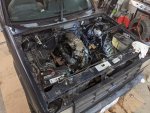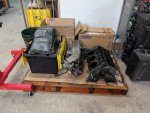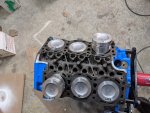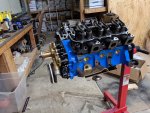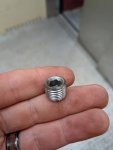BearitvRanger
New Member
- Joined
- Mar 2, 2021
- Messages
- 10
- Reaction score
- 0
- Points
- 1
- Location
- North Bend wa
- Vehicle Year
- 1989
- Make / Model
- ford ranger
- Transmission
- Manual
I have a problem with the old 2.9l v6 i just rebuilt for my 1989 ford ranger. after rebuild the oil pressure shoots down pretty much the same time the coolant temp starts to rise. i also noticed a slight smell of gas coming from the coolant? so far no leaks, no mix in coolant/oil. runs great, sounds great but it drops in oil pressure as soon as the truck warms up. also weak water pressure when warm. clearly something is wrong. Oil pressure is also very consistent when cold and will quickly drop. 5w30 conventional oil for first start, royal purple break oil in since, K&N oil filter
when building this I took the block, crank and new pistons to a machine shop for inspection and boring. the crank was undersized on journals & rods. new bearings are within spec. The block was bored and checked for flatness as well as hot tanked. the heads were replaced with new/remanufactured heads. valves lapped, lifters replaced. camshaft fine so it is stock. new pump.
they pulled all the plugs out for me before the hot tank and I think I might of not put one of the threaded plugs back. I've put a picture in the post with a red circle on it. this shows the coolant plugs I did put in on both sides of the block, but i was unable to find the location of the 3rd plugs home after looking over everything. the picture below is a threaded plug i got back from the shop but did not reinstall due to not finding a home for it (the plug fit well in the oil pressure sensor location).


I also replaced styles of oil sump pickups, could this effect the oil pressure when warm? picture below.

I'm pretty lost and have a lot of money into this and would like it running ASAP any input would be great!
when building this I took the block, crank and new pistons to a machine shop for inspection and boring. the crank was undersized on journals & rods. new bearings are within spec. The block was bored and checked for flatness as well as hot tanked. the heads were replaced with new/remanufactured heads. valves lapped, lifters replaced. camshaft fine so it is stock. new pump.
they pulled all the plugs out for me before the hot tank and I think I might of not put one of the threaded plugs back. I've put a picture in the post with a red circle on it. this shows the coolant plugs I did put in on both sides of the block, but i was unable to find the location of the 3rd plugs home after looking over everything. the picture below is a threaded plug i got back from the shop but did not reinstall due to not finding a home for it (the plug fit well in the oil pressure sensor location).
I also replaced styles of oil sump pickups, could this effect the oil pressure when warm? picture below.
I'm pretty lost and have a lot of money into this and would like it running ASAP any input would be great!
Attachments
-
249.2 KB Views: 126
-
226.4 KB Views: 129
-
227.3 KB Views: 125
-
233.2 KB Views: 130
-
1.1 MB Views: 149
-
71.5 KB Views: 170
-
344.9 KB Views: 120
-
102.4 KB Views: 135
-
109.1 KB Views: 123
-
101.8 KB Views: 129
-
123.3 KB Views: 121
-
93.9 KB Views: 118
-
91.7 KB Views: 132
Last edited:

